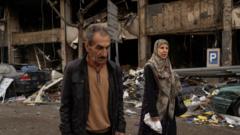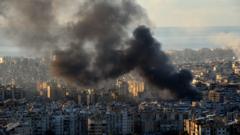Efforts to negotiate a ceasefire between Israel and Hezbollah have intensified, with Lebanon’s government expected to respond to a draft proposal presented by the United States. The diplomatic push comes amid escalating Israeli air attacks across Lebanon that have killed dozens of people in the past week.
Israel has significantly increased its military operations, targeting southern Lebanon, the eastern Bekaa Valley, and Beirut. The attacks have been particularly intense in Beirut’s southern suburbs, a Hezbollah stronghold. On Monday, central Beirut was hit for the second consecutive day, resulting in at least five deaths. A previous strike killed seven people, including Mohammed Afif, a prominent Hezbollah spokesman.
The recent attacks appear to be part of Israel’s strategy to pressure Hezbollah and the Lebanese government into accepting a ceasefire. The approach seems designed to expand the offensive by targeting non-military members and striking areas beyond Hezbollah’s traditional strongholds.
Potential peace negotiations are expected to be based on the United Nations Security Council Resolution 1701, which ended the 2006 war between Hezbollah and Israel. The proposed agreement would likely include:
– Removal of Hezbollah fighters and weapons from areas between the Blue Line and the Litani River
– Creation of an international monitoring mechanism
– Deployment of additional Lebanese army troops to southern Lebanon
– A timeline for Israeli force withdrawal
However, a significant point of contention remains Israel’s demand to retain the right to act inside Lebanon if any deal violations occur, which Lebanese authorities find unacceptable.
The conflict’s humanitarian impact has been severe. According to the Lebanese health ministry, Israel’s attacks have killed more than 3,840 people and wounded nearly 15,000 others. Over one million people have been displaced, further straining Lebanon’s already fragile economic situation.
From the Israeli perspective, the conflict aims to enable the return of approximately 60,000 residents displaced from northern communities due to Hezbollah’s rocket fire. Hezbollah initiated its campaign the day after Hamas’s attacks on southern Israel last year, claiming solidarity with Palestinians in Gaza.
Hezbollah’s attacks have resulted in 31 Israeli soldiers and 45 civilians killed. While Israeli air strikes have destroyed significant portions of Hezbollah’s infrastructure and eliminated many of its leaders, the group continues to conduct daily attacks, albeit with reduced intensity.
US diplomatic efforts continue, with Amos Hochstein, who has been leading negotiations, expected to return to Beirut pending clarifications about the Lebanese position.
The situation remains tense, with both sides carefully considering the proposed ceasefire while maintaining military pressure.



